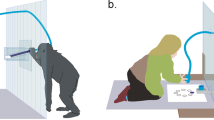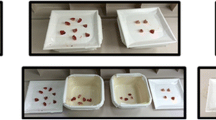Abstract
This study investigated whether physical discreteness helps apes to understand the concept of Piagetian conservation (i.e. the invariance of quantities). Subjects were four bonobos, three chimpanzees, and five orangutans. Apes were tested on their ability to conserve discrete/continuous quantities in an over-conservation procedure in which two unequal quantities of edible rewards underwent various transformations in front of subjects. Subjects were examined to determine whether they could track the larger quantity of reward after the transformation. Comparison between the two types of conservation revealed that tests with bonobos supported the discreteness hypothesis. Bonobos, but neither chimpanzees nor orangutans, performed significantly better with discrete quantities than with continuous ones. The results suggest that at least bonobos could benefit from the discreteness of stimuli in their acquisition of conservation skills.






Similar content being viewed by others
References
Beran MJ (2001) Summation and numerousness judgments of sequentially presented sets of items by chimpanzees (Pan troglodytes). J Comp Psychol 115:181–191
Beran MJ (2004) Chimpanzees (Pan troglodytes) respond to nonvisible sets after one-by-one addition and removal of items. J Comp Psychol 118:25–36
Bermejo M, Omedes A (1999) Preliminary vocal repertoire and vocal communication of wild bonobos (Pan paniscus) at Lilungu (Democratic Republic of Congo). Folia Primatol 70:328–357
Biro D, Matsuzawa T (1999) Numerical ordering in a chimpanzee (Pan troglodytes): Planning, executing, and monitoring. J Comp Psychol 113:178–185
Boysen ST, Berntson GG (1989) Numerical competence in a chimpanzee (Pan troglodytes). J Comp Psychol 103:23–31
Brainerd CJ, Brainerd SH (1972) Order of acquisition of number and quantity conservation. Child Dev 43:1401–1406
Brakke KE, Savage-Rumbaugh ES (1995) The development of language skills in bonobo and chimpanzee: I. Comprehension. Lang Commun 15:121–148
Brakke KE, Savage-Rumbaugh ES (1996) The development of language skills in Pan. II. Production. Lang Commun 16:361–380
Bruner JS (1966) On the conservation of liquids. In: Bruner JS, Olver RR, Greenfield PM (eds), Studies in cognitive growth: a collaboration at the center for cognitive studies. Wiley, New York, pp 183–207
Call J (2000) Estimating and operating on discrete quantities in orangutans (Pongo pygmaeus). J Comp Psychol 114:136–147
Call J, Rochat P (1996) Liquid conservation in orangutans (Pongo pygmaeus) and humans (Homo sapiens): Individual differences and perceptual strategies. J Comp Psychol 110:219–232
Call J, Rochat P (1997) Perceptual strategies in the estimation of physical quantities by orangutans (Pongo pygmaeus). J Comp Psychol 111:315–329
Cantor GN (1983) Conflict, learning, and Piaget: Comments on Zimmerman and Blom’s Toward an empirical test of the role of cognitive conflict in learning. Dev Rev 3:39–53
Davis H, Pérusse R (1988) Numerical competence in animals: Definitional issues, current evidence, and a new research agenda. Behav Brain Sci 11:561–615
Elkind D (1961) The development of quantitative thinking: A systematic replication of Piaget’s studies. J Gen Psychol 98:37–46
Gelman R (1972) Logical capacity of very young children: Number invariance rules. Child Dev 43:75–90
Gelman R (1982) Accessing one-to-one correspondence: Still another paper about conservation. Br J Psychol 73:209–220
Gruen GE, Vore DA (1972) Development of conservation in normal and retarded children. Dev Psychol 6:146–157
Halford GS, Boyle FM (1985) Do young children understand conservation of number? Child Dev 56:165–176
Kaplan G, Rogers LJ (2000) The orangutans. Perseus, Cambridge, Mass.
Malenky RK, Wrangham RW (1994) A quantitative comparison of terrestrial herbaceous food consumption of Pan paniscus in the Lomako Forest, Zaire, and Pan troglodytes in the Kibale Forest, Uganda. Am J Primatol 32:1–12
Muncer SJ (1983) “Conservations” with a chimpanzee. Dev Psychol 16:1–11
Peisach E, Hardeman M (1975) The role of atomism in the development of conservation. J Genet Psychol 126:217–225
Piaget J (1961) The genetic approach to the psychology of thought. J Educ Psychol 52:275–281
Piaget J (1964) Development and learning. J Res Sci Teach 2:176–186
Piaget J (1997) The child’s conception of number. Routledge, London (original work published 1941)
Piaget J, Inhelder B (1941) Le développement des quantités physiques chez l’enfant [The development of physical quantities in the child]. Delachaux et Niestlé, Neuchâtel
Piaget J, Inhelder B (1969) The psychology of the child. Routledge, Paul, London (original work published 1966)
Rumbaugh DM, Savage-Rumbaugh S, Hegel MT (1987) Summation in the chimpanzee (Pan troglodytes). J Exp Psychol Anim Behav Proc 13:107–115
Samuel J, Bryant PE (1984) Asking only one question in the conservation experiment. J Child Psychol Psyc 25:315–318
Savage-Rumbaugh ES, Sevcik RA, Rumbaugh DM, Rubert E (1985) The capacity of animals to acquire language: do species differences have anything to say to us? Phil Trans R Soc Lond B 308:177–185
Shaffer JP (1995) Multiple hypothesis testing. Annu Rev Psychol 46:561–584
Silberberg A, Fujita K (1996) Pointing at smaller food amounts in an analogue of Boysen and Berntson’s (1995) procedure. J Exp Anal Behav 66:143–147
Shumaker RW, Palkovich AM, Beck BB, Guagnano GA, Morowitz H (2001) Spontaneous use of magnitude discrimination and ordination by the orangutan (Pongo pygmaeus). J Comp Psychol 115:385–391
Smedslund J (1961) The acquisition of conservation of substance and weight in children: VI. Practice on continuous vs. discontinuous material in problem situations without external reinforcement. Scand J Psychol 2:203–210
Suda C, Call J (2004) Piagetian liquid conservation in the great apes (Pan paniscus, Pan troglodytes, and Pongo pygmaeus). J Comp Psychol 118:265–279
Tomasello M, Call J (1997) Primate cognition. Oxford University Press, New York
Tomonaga M, Matsuzawa T (2002) Enumeration of briefly presented items by the chimpanzee (Pan troglodytes) and humans (Homo sapiens). Anim Learn Behav 30:143–157
Woodruff G, Premack D, Kennel K (1978) Conservation of liquid and solid quantity by the chimpanzee. Science 202:991–993
Acknowledgements
We thank the staff of the Wolfgang Köhler Primate Research Center for their support, and Daniel Stahl for statistical advice. Chikako Suda also would like to thank Laurence King and Franklin Chang for grammatical correction of the manuscript. A part of this study was presented at the Eighth Conference of the German Primate Society in Leipzig, Germany in October 2003. The current experiments comply with the laws of the country in which they were conducted.
Author information
Authors and Affiliations
Corresponding author
Rights and permissions
About this article
Cite this article
Suda, C., Call, J. Piagetian conservation of discrete quantities in bonobos (Pan paniscus), chimpanzees (Pan troglodytes), and orangutans (Pongo pygmaeus). Anim Cogn 8, 220–235 (2005). https://doi.org/10.1007/s10071-004-0247-6
Received:
Revised:
Accepted:
Published:
Issue Date:
DOI: https://doi.org/10.1007/s10071-004-0247-6




